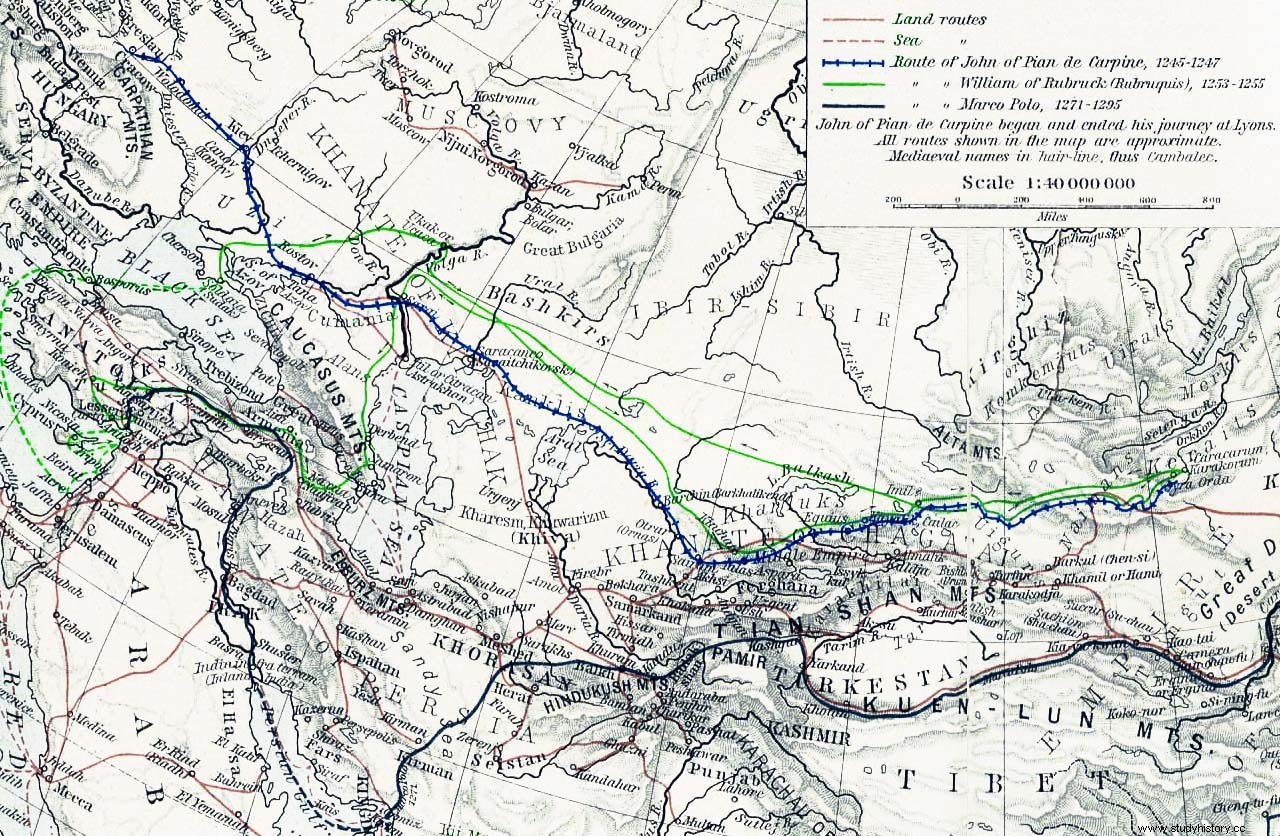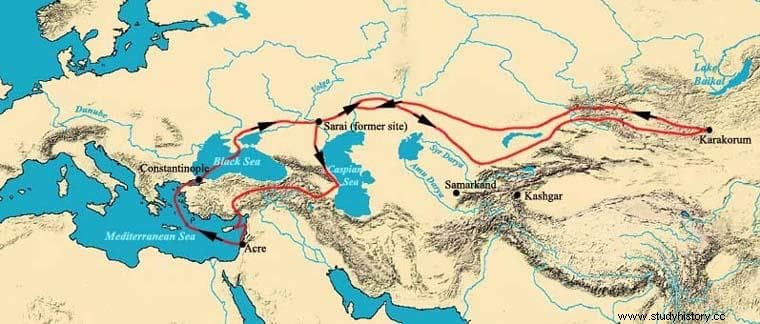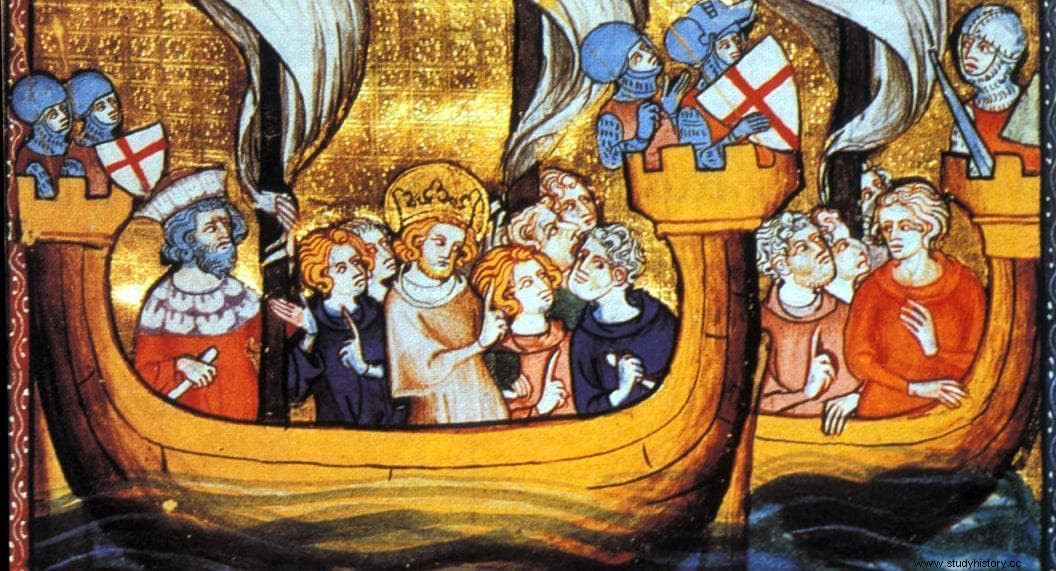Willem van Ruysbroeck was a Franciscan monk, better known in Spain as Guillermo de Rubruquis, sent by the King of France as ambassador to the Great Khan.
A few days ago we narrated the travels of Julianus, a Dominican who in the Middle Ages traveled through Eastern Europe in search of Magna Hungary and he found her, but when he returned on a second try he was met by a wave of Mongol invaders and they tasked him with bringing an ultimatum to his country, among many other adventures. A decade and a half later, Rubruquis followed the itinerary described by Julianus.
To be exact, his name was Willem Van Ruysbroeck and he was Flemish , born in Rubrouck (a city in the far north of France today) around 1220.

If his predecessor wore the Dominican habit, Rubruquis wore the Franciscan and entered the service of the Gallic monarch Louis IX , whom he accompanied on the Seventh Crusade which he led between 1248 and 1254 as thanks to God for saving him from death the year before, when he was sick with malaria.
The campaign aimed to conquer Egypt to pressure from there the Muslims, who had reoccupied Jerusalem after the end of the ten-year truce that followed the Sixth Crusade. But epidemics and famine hit the Christian troops and the adventure ended in resounding defeat, from which Luis and his men escaped by paying a huge ransom and retreating.

Meanwhile, Rubruquis had become an expert geographer , good connoisseur of classics such as the work De mirabilibus mundi of Cayo Julio Solino among others. This theoretical training, together with the experience of Egypt, seemed to the king a good resume to entrust him with an important mission:march to Asia to meet the Mongols as theirambassador and, incidentally, try to convert them to Christianity; If Luis had not been able to return the divine favor by expelling the infidels from the Holy Places, he would at least try to win souls.
The Franciscan moved from Acre to Constantinople accompanied by another friar named Bartholomew of Cremona , in addition to his assistant Gosset and an Arabic interpreter named Abdullah but whose meaning (Servant of God) was Latinized as Homo Dei . From the Byzantine capital they set out on May 7, 1253 following the same route undertaken by the Hungarian Julianus, described in its first episode by the amanuensis Riccardus and the rest of his own handwriting under the title Levél a tatárok életéről (Letter on the life of the Tatars).
Traveling to the East, they crossed the Black Sea by boat to reach Crimea , where the Genoese had established a commercial factory. Then, from Soldaia, they went to the other end of the peninsula and continued northeast on an oxcart, entering Tartaria; it was a vast region stretching between the Caspian Sea, the Ural Mountains, and the Pacific Ocean, encompassing parts of present-day Ukraine, Russia, Turkestan, Mongolia, Manchuria, and even Siberia.

The expedition was then in the Muscovite Tartary, the westernmost, opening before them the immense steppe, a territory that at that time was integrated into the Golden Horde , the great khanate formed a few years earlier from the conquests of Batu Khan, the grandson of Genghis.
Rubruquis and his companions crossed the Don and nine days later made contact with Sartak Khan , the ruler of the Golden Horde, who, being a Nestorian Christian, a current broken off in the 5th century and considered heretical by Rome, received them well and gave them a safe-conduct to visit his father, Batú Khan , lord of the Volga region.
They appeared before him shortly after, taking advantage of all that time to write down what they saw:geography, customs, gastronomy... Batú also received them cordially but refused to convert; instead, he authorized them to present themselves as ambassadors to the Great Khan, who in those days was Möngke , another grandson of Genghis and brother of the famous Kublai, and who had risen to the throne in 1251 thanks precisely to the support of Batú.
As Möngke had reversed the direction of Mongol expansion, focusing on China instead of Europe (in fact he would die in 1259 in a campaign against the Chinese), the scope of his dominions extended endlessly towards the East.

Thus, the Flemish monk returned to the roads entering Central Asia; Julianus had not gone that far but now he was following the itinerary that another friar had previously opened, the Italian Giovanni da Pian del Carpine . After crossing the Ural and Ili rivers, leaving behind the cities of Ecquius and Cailac, passing by Lake Baikal and passing through Imil (present-day Kazakhstan), he reached the city of Ulus in early 1254.
There he discovered that there was a small Nestorian community protected by Möngke himself and then continued to the capital, Karakorum, where two missionaries had brought the Christian faith a few years earlier (Ascelin of Lombardy in 1245 and André de Longjumeause in 1249) and where intense theological debates -with moderator and everything- between the three great religions settled in that part of the world (Christianity, Buddhism and Islam); Rubruquis himself participated in some while he continued to take notes of what he saw and was finally received by the Great Khan.
Rubruquis remained there until the summer. Then, as if the 9,000 kilometers traveled were not enough, he began his return to France with Möngke's response on the conversion offer; negative, obviously, and also demanding vassalage from the French king. He left on July 10 -curiously two months before the birth of another famous traveler who would achieve fame, Marco Polo- and it took him a year to reach Tripoli by a different route, skirting the Caspian Sea to the south and leaving behind Caucasia, Persia, Armenia and Cyprus.
When he finally appeared before Louis IX he gave him a fascinating account entitled Itinerarium fratris Willielmi de Rubruquis de ordine fratrum Minorum , a compendium in forty chapters of geography, anthropology and ethnography of the country of the Mongols - apart from his personal experience - and in which he reported an important discovery: the Caspian was an inland sea and not the result of a flow coming from the Arctic, as was believed.
The Itinerarium , often more simply known as Journey through the Mongol Empire it is a book considered to be on a par with Il milione of Marco Polo, although without the fantasies which, paradoxically, made this one more popular.
